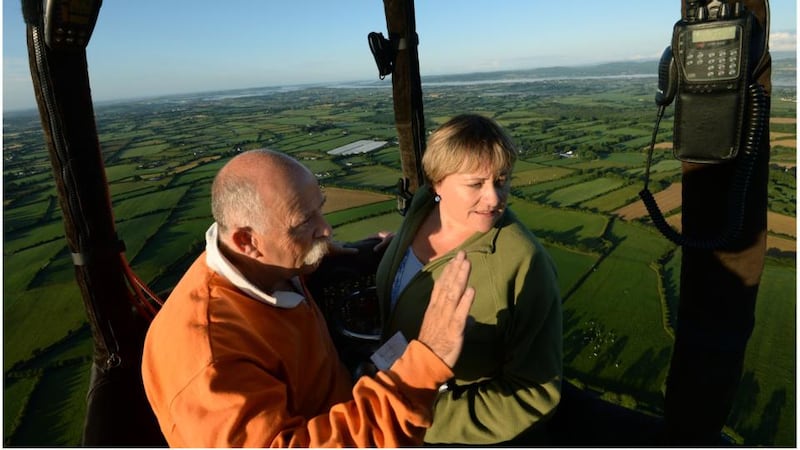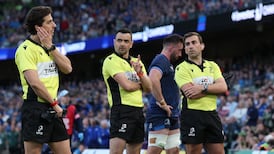Coast. That's what they said. So we do, slipping our mooring at first light and sailing into the pink dawn above Waterford Estuary. Past the train station and down the river, we drift on the morning breeze, watching as the Suir gives way to the sea.
The sleeping midweek city slowly recedes. Tramore sprawls in the distance, a seaside town more extrovert than its compact medieval neighbour. Three white pillars on the headland near Newtown Cove gleam in the sun, serving as a warning to unwary sailors.
The Metal Man stands on one of them, still smart in his British uniform and pointing out to sea, as he has done since 1823. If you come too close in a storm you might have the misfortune to hear his chant: “Keep out, keep out, good ships from me, for I am the rock of misery.” But we won’t come too close. The wind won’t allow it.

It’s hard to go coastal when you’re becalmed in a wicker basket beneath a balloon in Kilmacow. So we aren’t keeping strictly to the marine route, but what of it?
A balloon trip is a magical mystery tour. There is no steering. There are no motors. Balloonists travel at the whim of the wind, exact destination unknown. They are the original followers of One Direction, a fan club stretching back to the 18th century and the Montgolfier Brothers.
Joe Daly is our skipper. He is one of a handful of qualified balloon pilots in Ireland and is passionate about his sport. He sports a bushy moustache – a mini handlebar – whiskers of choice for the adventuring aviator. When he isn’t floating across the sky (his dream is to cross the Serengeti), he lectures in marketing at the Waterford Institute of Technology.
In ballooning, nothing happens without the weather’s consent. After the terrible conditions of the past few years, this summer has been kind to Ireland’s small band of enthusiasts.
Joe has decided we will launch from the People’s Park. It’s a stunning morning: the rose-tinged clouds clear with the dawn and leave behind a perfect blue sky.
Pilots need their ground crew – usually volunteers who love the sport – who help prepare the balloon for launch, then retrieve it and the passengers after they land.
Photographer Brenda Fitzsimons is the third passenger on our flight. Brenda is an experienced balloonist and flies regularly. She lends me a pair of wellies before we set off. Landing conditions can be mucky underfoot, it seems. And sometimes you could be dragged along the wet ground before coming to a halt.
There is no door in the wicker gondola – but our creaking 30-year-old basket, faithful to a centuries-old design, is still considered the market leader: strong but flexible, with great shock-absorbing qualities.
Retrievers John, Shay and Zack (Joe’s 15-year-old son, who plans to collect his pilot’s licence on his 17th birthday) lay out the fabric in a thin line along the wet grass. The basket is turned on its side with the steel burners now secured to four poles in the corners. Lines are attached.
I help to hold open the mouth of the envelope as Joe prepares to fire up. We fall silent.
Then, all of a sudden, “whooooosh!” With a deafening roar and a terrifying blast of heat, two enormous plumes of fire burst from the burners towards the opening. I nearly die with the shock.
“We were waiting for that. It always happens the first time,” says Shay.
Our balloon should be called Leinster House: it’s a well-stuffed envelope full of hot air. The burner must be Bernard Durkan, the amiably voluble Fine Gael TD from Kildare, who could inflate for Ireland.
A few more blasts on Bernard the burner, and Leinster House puffs up, lifting the small basket upright. So there are Joe, Joe’s moustache, Brenda, Brenda’s cameras, a flight kit and three large propane gas cylinders already inside. It’ll be a tight squeeze.
There is no door in this gondola, only a little hole cut low in the side to act as a step. My footmen are on a day off. I improvise with a modified Fosbury flop, and topple in sideways like a tipsy gnu.
Our balloon is free and lifting fast, without a sound or any sensation of movement. Skimming the trees and out over the city, we rise until we can read the broad looping signature of the Suir across the streetscape and tidy farmland beyond.
The bridges across the estuary, from the geometric cables of the new suspension bridge to the gap-toothed and abandoned Red Iron Bridge, follow an engineering timeline.
Balloon pilots are obliged to carry two pieces of equipment: an altimeter and a timepiece. Time is important because it seems to stop in the stillness . . . until suddenly your propane tanks are empty.
We drift towards the sea. To our left, Wexford and the curling arm of Hook Head. Waterford and Brownstown Head beckons to the right.
But the wind is our navigator.
Joe Daly injects a few blasts from Bernard the Burner and the hot air powers Leinster House to new heights.
The breeze takes us to south Kilkenny. The ancient ruins of Grannagh Castle look mystical in the misty air. Tory Hill looms like a Teddy Boy’s quiff.
Joe reckons he can land us in the vicinity of Mooncoin.
Animals sense our presence. Dogs run out of houses, barking. They can hear the strange whoosh of the burner, 3,000ft above. We can hear everything too, right down to the birdsong in the hedgerows.
As the sun climbs, our balloon casts a moving shadow on the fields – an inverted teardrop darkly flitting across the landscape. The cattle pause to watch.
There is a special muffler for the burners, which the pilot uses when passing animals, as horses are sometimes spooked by the sound and cows can stampede if the balloon comes too near.
The south Kilkenny ladies look up at us curiously then continue on their way to the parlour.
Joe points to a beautiful spot where clouds of white morning mists shroud water and land. “That’s where the Three Sister meet. The Barrow, The Nore and The Suir.”
We’ve been flying for more than an hour, but feel no need to button up or batten down a hat. You expect to be buffeted in the open basket, but it is utterly calm.
We hang, becalmed, somewhere near Kilmacow. Joe shouts down to a man out walking his dog on a country road.
“Good morning! Where are we?”
He looks up. “Where did you start from?”
We drift on and Joe tries again, hailing a farmer. “Where are we? Mooncoin?”
“Where are you going?” is the reply.
“Don’t know yet.”
About 70 minutes after take-off, we land in a field on Tom Quinn’s beautiful farm in Killinaspic. We bend our knees, brace and hang on to the side of the basket. There’s an almighty thump and we fall backwards. With one final blast from the burner we rise a little bit again, before settling softly in the lush dewy grass. A perfect landing.
The retrievers do their job. We're back in Waterford in time for breakfast.
Waterford coast: A varied stretch
The Waterford coastline is quite varied, with dozens of beaches situated on a volcanic stretch of coast, particularly condensed around the area known as the Copper Coast, which extends for about 25km west of Tramore. This area is named because of its former mining industry, and has been awarded Unesco status as a place of significant geographical status.
The mid-Waterford coast, which has an area of high coast and sea cliffs, runs from Newtown Cove to the east, to Ballyvoyle to the west, and is marked as an area of special protection because of the birds found there, including herring gulls.
Some of the main beaches on the Waterford coast include the five-kilometre Tramore strand, which contains great walking routes such as the Cliff Road and Doneraile walks. A bustling seaside resort with funfair attractions has been built around the strand.
For a more traditional offering, Dunmore East (below), with its thatched cottages and fishing-village feel, should also appeal.
Attractions and activities: Surf, sand, sea and swimming
With prevailing southwesterly winds, Tramore (below) is good for water sports such as surfing. There are four surf schools on the beach, and public toilets and showers at the promenade area.
For swimming, the nearby Guillamene is Waterford’s equivalent to Dublin’s Forty Foot. Other swimming areas worth visiting include Stradbally Cove, which is ideal for small children, and Benvoy, at the foot of the Copper Coast cliffs between Tramore and Bunmahon.
In terms of hidden gems, Trá na Mo is accessible via a cliff walk, after parking at Bunmahon beach town entrance. Walk up the hill to the right and the secluded beach is below you. The area around Ardmore, a lovely seaside town, contains some nice beaches, such as Goat Island, Ballyquin, the Curragh, and Whiting Bay.
Another major attraction is the Copper Coast Geopark, an outdoor museum of geological records. There’s also a self-guided Copper Coast trail, with walking cards available from the Geopark Centre.
Then there’s the Fenor Road Bowling Social Club. Members head out on the coast road from Fenor village every Sunday from 11.30am to 1.30pm. Newcomers are welcome.
Newer activities in the region include stand-up paddle-boarding in Tramore, as well as kite-surfing.
The Anne Valley nature walk in Dunhill – a scenic 2.2km path worth making a detour for – opened earlier this summer.
For eating spots, try the Copper Hen in Fenor, opened in 2010 by chef Eugene Long and his wife, Sinéad Frisby, which specialises in locally sourced produce.
The Tannery on the quayside in Dungarvan is another award-winning spot, and accommodation is also available in a lovely townhouse nearby. The owners run regular cookery courses with chef Paul Flynn.
One of the most scenic spots along the coast is The Cliff House Hotel in Ardmore, which has a Michelin star restaurant and is adjacent to some of the best coastal walks in the country.

















